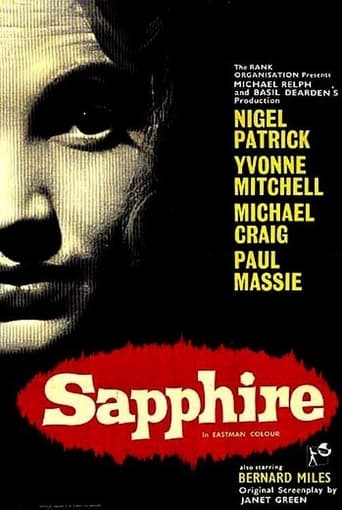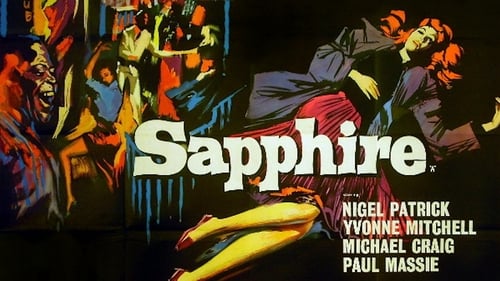lucyrfisher
This film really is as good as everybody says. Nigel Patrick makes an excellent principled investigator. His younger sidekick is the one who casually lets fall a succession of racist myths. A girl is found stabbed on Hampstead Heath - it turns out she is a music student with a serious, striving boyfriend. But the cops are surprised by the red taffeta petticoat she wears under her sober "tweed" skirt. (It's a brown, with sunray pleats.) When her brother turns up, they discover that she is "coloured", and has been passing for white. Much of the investigation focuses on the boyfriend's family, who are aspirant, respectable working class. His dad is a sign painter played by the great Bernard Miles. One of the film's many virtues is that we SEE him painting a sign, and see his workshop at the back of the house in a former stable block. The family stand together and assert that they accepted Sapphire, background, pregnancy and all.Londoners love films set in our city decades ago. Oh, look, I remember those Victorian shops, those buses! There are many excellent bit players, including a couple of landladies – one who says "I run a WHITE house" while smiling crookedly. Another wears a Cairngorm brooch and says she would have thrown Sapphire out if she'd "known". The past wasn't all that cosy. Sapphire's brother says he'll stay at a certain hotel which will "take us".The film is in colour, all the better to show off the garish underwear. There is a wonderful visit to Babette's lingerie shop in Shaftesbury Avenue. The detectives hold up a bright pink nylon negligee with some disgust. Stereotypes fly - a girl may look white, but if she has black ancestry she can't resist the rhythm of the bongos. There are many black characters - more than in most TV dramas or films of today, and they all impress. One is a dandy with a bishop for a father. There are some dubious types hanging out in an empty house. A dimwitted suspect goes on the run through the mean streets and the film reaches another level. He's beaten up by some "teddy boys" and takes refuge in a newspaper shop run by a kindly (white) old couple.It's about this point the watcher realises that this is no standard detective story. The acting is superlative, especially from the boyfriend's family - his worried mother, and fraught sister, whose husband is permanently "at sea".Exteriors are drab because that's how they were. But interiors are carefully painted to look as dreary as possible - perhaps to show up snappy suits and orange lipstick. But were walls and furniture really painted in shades of brown or grey? There's a lovely scene early on where Sapphire's student friends discuss her in Foscari's coffee bar. I wish we'd seen more of them.
kapelusznik18
****SPOILERS*** Murder in 1950's London England that turned out to have deep racial overtones in who the victim was. Found with her throat slit in a deserted park the lily white looking Miss. Sapphire Robbins, Yvonne Buckingham, is soon to be discovered to be black in her Negro bother Dr. Robbins,Earl Cameron, showing up at the police station to identify her. This throws the whole case into limbo in that it was very probably her being discovered to be black not white that lead to her murder! It's Sapphire's white boyfriend David Harris, Paul Massie, who becomes the #1 suspect in her murder who was planning to marry her which at the same time could disqualify him from his hard earned scholarship to attend Oxford. That for not only being married by marrying someone outside his own race!As police superintendent Robert Hazard, Nigel Patrick, and his sidekick inspector Phil Learoyd,Michael Craig, check out where Sapphire spent the last few hours of her life they soon realize that those of the black community in the night and dance clubs that she spent her time in knew that she was black or one of them! And her about to marry a white man, David Harris, is what may have triggered a black boyfriend of her to murder Sapphire in a jealous and violent fit. As for the devastated David Harris he seemed to know the reason why Sapphire was murdered and even more important who murdered her! But in is keeping his mouth shut he may very well ends up paying with his life, by being arrested convicted and hanged, for it!****SPOILERS**** Down to earth and not so self conscious and apologetic of race issues, like later likewise movies about race, "Sapphire" sticks more to finding Sapphire's killer then trying to make a politically correct case out of it. There are a number of black suspects, who were anything but boy scouts or altar boys, also involved in Sappire's murder who for the most part were shown to have deep seeded racial prejudices as well. Not only against whites like David Harris and the white police but against Sapphire herself. For the "crime" of passing herself off as white and planning to marry a white man making the reason, in racial terms, for her murder cut both ways! The film didn't have the usual cop-out ending that you would have expected in Sapphire's killer being both close to home and at the same time it wasn't race that was the main reason for murdering her. But mostly for status in the community and economic freedom & security instead!
writers_reign
My summary does double duty as a description of the eponymous character, a very light-skinned West Indian girl 'passing' for white and the film itself, a low-key exploration of racial tension in pre-Swinging Sixties England. In terms of police-based drama we were still in the era of Dixin Of Dock Green with the more realistic Z Cars and The Sweeney still to come so that Nigel Patrick's Inspector comes across as a gentleman detecting as something of a hobby, an exact counterpart, in fact, of Raffles, the gentleman crook. The teenagers are unbelievably polite, dress conventionally and are unable to field a single tattoo, piercing, stud or pin in a college full whilst the prejudice is recorded mutely rather than trumpeted. Despite the odd and obligatory red herrings the real killer is not difficult to spot and the motive is all too plausible. Patrick takes the acting honours as one would expect with Michael Craig contributing his usual hundredweight of balsa wood but all in all it is both interesting and satisfying.
robert-temple-1
This is one of the most shocking films ever made about the true depths of colour prejudice in Britain in the 1950s, and the violent hatreds of black people harboured at that time by the white British working classes, especially in London. The film is well-scripted, and boldly directed by Basil Dearden, and it shows without flinching the true state of feeling as it was in those days (with some strong anti-white prejudice by blacks thrown in, to demonstrate that things are never only one way). What is so utterly horrifying about watching all of this now is, that it really was all true then. It is inevitable that some of the characters both white and black should resemble stereotypes, perhaps for the reason that at that time, people genuinely were stereotypes. The story concerns a police investigation of a murder of a young girl who was a student at the Royal Academy of Music (half way through the film a policeman calls it the Royal College of Music; Londoners are always confusing the two separate institutions in that way, so perhaps this script flaw merely reflects real life). Her body is found on Hampstead Heath in London, and there are no clues apart from the initial 'S' (her name is eventually discovered to be Sapphire). As a crime investigation thriller, the film is solid and extremely well done. A spectacular cameo performance is given by the black actor Robert Adams as 'Horace Big Cigar', not long before he died. The acting is all reliable and convincing. Dearden is especially good at not allowing any of the women and children to scream when discovering a body or having a horrible experience: his technique was extremely subtle, and they instead stifle screams, a scream begins to form, and then they put their own hands over their mouths in horror. When identifying a corpse, the actor behaves as one would naturally do, with numb paralysed shock, remaining silent and staring. All the ridiculous Hollywood histrionics and stock reactions of approved hysteria and screaming females are eliminated from this very British film, in which there is no place for hysteria except with one black character who panics for story reasons. Sociologists should really see this film. However, it is so incendiary that I cannot see it ever being released again or even being shown on television, at least not in Britain. In fact, some of the comments in the film may even have become 'illegal' under the harsh new race relations laws, even in a fictional context! Anyone who thinks race problems have gone away does not know human nature. Sensitivity to small differences, such as skin colour, is so firmly rooted in animal behaviour (the isolation by the herd of the black sheep, the driving away of albino animals from the pack), that race hatreds are inescapable, and can only be suppressed, never eradicated. Seeing this film reminds one of this depressing aspect of life by a blatant portrayal of it which is almost too painful to watch.




